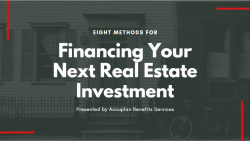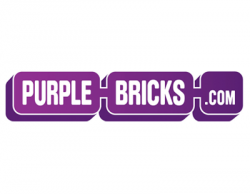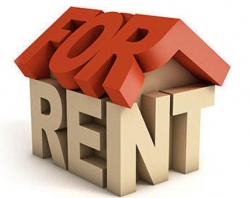It’s not hard to understand why investors love real estate. It works to hedge against market volatility, diversify an investment portfolio, and provide a tangible asset option outside of paper assets.
Real estate as an investment is a great way to generate passive income, but one hurdle for many would-be investors is the money required to begin. For many, the answer lies in taking out a loan, but some investors fail to realize that there are dozens of alternative options to a traditional home loan.
Financing an investment property has several well-trusted methods, and there are particular criteria that the borrower would need to meet for each. Choosing the wrong type of financing can impact the success of an investment, especially one of such size (both in the literal size of the home and the amount of money being borrowed). Educated investors are intelligent investors, so understanding the requirements of each financing option is vital for success.
The true beauty in real estate is that anyone can purchase it. But the issue comes with financing. 90% of real estate purchases are made with the buyer incurring debt. But there are methods anyone can utilize that don’t require that you put yourself in a tough spot.
Lease Option
A lease option is an aspect that is not common among real estate investors looking to purchase a property with no money down. However, the lease option can be an invaluable strategy when buying a property for real estate investors and homebuyers alike.
The lease option allows you to purchase a property with no money down by renting it and paying off its price through the rent. This typically results in you having to pay higher rents, but the extra amount that you pay will go towards purchasing the property without having to pay any money down.
The specific terms of the lease agreement can vary significantly since all portions of the contract are negotiable. Most require a non-refundable deposit, which can range from 2% to 7% of the sales price, and they may require the tenant to pay property taxes and maintain the property during their lease option term.
Typical terms you might see on a rent-to-own contract include:
- The purchase price, which can be the asking price or above market value.
- Length of contract (typically one to three years).
- Monthly rent amount and how the monthly payments will be applied if the option to purchase is executed.
Cash Option
24% of US investors use cash to finance real estate investments, which is the easiest and quickest method of purchasing investment properties.
Most importantly, investors can frequently purchase a property at a lower price with all cash and a quick close, which increases their profitability.
An investor typically pays the title company with certified funds or a wire transfer when paying all cash, and the title company pays the seller.

Hard Money
Hard money loans are backed by the value of the property, not the creditworthiness of the borrower. As a result, hard money loans have lower loan-to-value ratios than traditional loans and typically have a higher interest rate than most other forms of financing.
Hard money loans are usually used by real estate investors on a short-time basis, perhaps while rehabbing an investment property or securing longer-term financing. Though the interest rate is higher than other types of funding, it allows investors to purchase an investment property, rehab it quickly, and make a profit.
Hard money loans are generally short-term loans, lasting from one to three years. You use them as a quick way to get money for a purchase. However, you wouldn’t want to keep one of these loans for an extended period because interest rates for hard money are typically relatively high. For instance, the average interest rate for hard money loans in 2020 was 11.25%.
Retirement Accounts
Individual 401K
An Individual 401K is another method of financing real estate investments with retirement savings.
Unlike a traditional 401K, a self-directed Individual 401K allows investors to choose investments held in the 401K, including precious metals, real estate, stocks, bonds, etc.
Individual 401Ks allow you to invest virtually tax-free, like a traditional 401K plan. But with an Individual 401K, you direct which investments are made, and you have the option to invest in real estate.
Like a self-directed IRA, self-directed Individual 401Ks have rules that you must carefully follow, so consult your financial advisors or self-directed IRA provider for options and regulations.
Non-Recourse Loan
The difference between recourse and non-recourse loans is that in a non-recourse loan, if the borrower defaults (i.e., the IRA), the lender/issuer can seize only the collateral, which is usually the property purchased through the IRA. The underwriter of the non-recourse loan only uses the IRA’s ability to repay the loan back.
Since the IRA holder cannot extend their creditworthiness to the IRA, the IRA investment must have enough income to warrant the lender to fund the non-recourse loan. Most lenders will only fund multi-family dwellings to mitigate risk. To lessen the risk of repayment, non-recourse lenders typically require the IRA to put a larger down payment.
A Self-Directed IRA
Using a self-directed IRA to finance investment property is a terrific way to diversify retirement savings while creating a portfolio to generate passive income throughout retirement.
Most importantly, investors can finance investment properties with non-recourse loans when using a self-directed IRA.
There are several rules involved with a self-directed IRA, so be sure to consult your financial and tax advisors for options, including setting up a Self-Directed IRA LLC (also known as a checkbook IRA).
Opening your own Accuplan self-directed IRA takes only a few minutes, begin the application below.
Bank Mortgage
A conventional mortgage can be used to finance an investment property, but there are more restrictions with these loans than owner-occupied home loans.
The down payment to finance investment property with a conventional mortgage is 20% or more. Additionally, most lenders limit the number of investment properties they will finance with a mortgage for a single investor while limiting the total amount of money they will lend the investor. Therefore, a conventional mortgage is usually an option only for smaller investors who have few properties.
Know your (lending) limits
Fannie Mae currently allows each investor to carry ten loans at once. If you’re working with the right lender, they can help you strategize both a long-term and short-term plan to ensure that you’re taking advantage of your 10-loan limit.
It’s worth noting that many lending institutions will only lend up to four loans (typically the bigger banks). You’ll likely have to do a little leg work to find a lender that will go up to the 10-loan limit.
The more loans you have, the stricter the credit requirements
As mentioned before, Fannie Mae currently allows up to 10 loans per investor. A little-known fact is that there are two different credit-qualification guidelines for obtaining these loans. The first is for properties 1-4, and the second is for properties 5-10, listed below:
- Loans 1-4: requires a credit score of at least 630
- Loans 5-10: requires a credit score of at least 720
Assuming an Existing Mortgage
The buyer of a real estate property could negotiate a deal with the seller to assume its existing mortgage and pay it off instead of a down payment. This method can be highly successful and advantageous for the buyer, especially if the mortgage has a low interest rate.
Why an Assumable Mortgage?
The short answer? A buyer might want an assumable mortgage because a lower interest rate and reduced closing costs can save them big bucks.
Mortgage Costs
The overall savings would be considerable if a lender offered creditworthy buyers 30-year fixed-rate mortgages at 10% interest, and the seller had an assumable mortgage at 5%. A $250,000, 30-year fixed-rate mortgage provided at a rate of 10% would result in monthly payments of $2,193.93, while the same mortgage at 5% would result in monthly payments of $1,342.05.
Overall, the finance charges alone on the 10% mortgage would amount to more than twice the original amount, or $539,814.41. The 5% mortgage would not cost quite double the original amount borrowed, or $233,139.46.
Keep in mind, however, that not all loan types can be assumed by someone else. Make sure to research the types of loans and mortgages before using this method to ensure that it is viable.
Partnerships
Partnerships are widespread in real estate investing. A real estate investor might not have the necessary funds to purchase a property with no money down, but they might possess the skills required to manage the investment and make it succeed. In this case, it is possible to find a real estate partner who has sufficient funds to finance the purchase of the property while you manage the different aspects of the investment.
Ensure that the real estate partnership terms are set and agreed upon. The allocation of the profits and the responsibilities should be fair to all the partners involved in the purchase.
Real Estate Partnership Entities
You can form a real estate partnership through a variety of “pass-through” entities. Each of these real estate partnership formations provides dual benefits to investors. The three most common entity partnerships are:
- LLC or Limited Liability Company
- LLP or Limited Liability Partnership
- S-Corporation
Taxation is eliminated on a corporate and personal level since income or losses are passed through to each investor for reporting on an individual tax return. These entities also provide legal protection from claims against other business or personal assets belonging to each investor that are not part of the partnership.
Real Estate Crowdfunding
Real estate crowdfunding is a new method in which investors band together, typically online, to pool their funds and invest in opportunities they would be unable to finance independently. This method of investing involves much less money upfront and is considered passive.
Some online platforms for real estate crowdfunding are open to general investors, but many require users to prove a certain income level before investing.
High dividends
Since most crowdfunded real estate sites work through REITs, investors get to reap their benefits. REITs, both public and non-traded, are legally mandated to pay 90% of their taxable income to investors. Because of this, many REITs offer a strong history of dividends.
Low investment minimums
Some of these platforms have low investment minimums. Most platforms offer a starter portfolio with an investing minimum of $500. This hurdle may sound high, but it’s lower than the minimums commonly charged by privately owned REITs (often in the thousands) while still giving investors access to privately held assets.
























